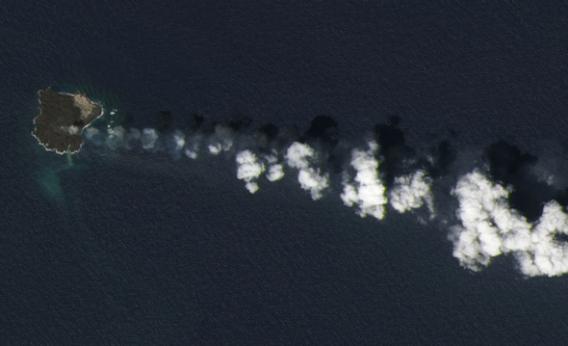Create a free profile to get unlimited access to exclusive videos, sweepstakes, and more!
A New Volcanic Island Swallows Its Older Sister

Tens of thousands of years ago, an undersea volcano a thousand kilometers south of Tokyo reached a milestone: Its peak reached the surface of the Pacific Ocean. It became an actual island. For millennia it slept, but in the 1970s a series of eruptions grew the island, which was named Nishinoshima. It was tiny, just a couple of hundred meters across.
But then there were a series of eruptions just south of the island in November 2013, in a still-submerged part of the volcano. This created a second peak, which poked through the water’s surface to become a new island just a few hundred meters from Nishinoshima.
That wouldn’t last: The new island grew as the volcano continued to erupt, and just before New Year’s Day 2014, the new island grew so big it actually connected to the old island. Now there is just one … and it’s still erupting, as you can see in this lovely image taken by the Landsat 8 satellite on March 20, 2014:
The new, merged island is about 1,200 meters (3/4 miles) across, and the volcanic cones reach about 60 meters (200 feet) above sea level. The Japanese Coast Guard has been watching the island carefully and has many dramatic pictures of it; here’s my favorite:
The Landsat picture is pretty cool; you can see the island itself on the left (north is to the right), and the actual volcanic plume as a faint gray streak. The puffy white clouds are forming as water droplets condense around the particles in the plume. This is called nucleation. This process is how all clouds form, though usually it’s from dust in the air, not volcanic material! I like how the plume appears to come out in puffs (possibly from cyclic volcanic pumping) and the clouds follow the same pattern. This goes on a long way, for dozens of kilometers downwind:
Our planet is an active one, constantly churning and moving. Old land is subducted under continental plates, and new land forms as volcanoes take the guts of the Earth and eject them onto the surface. This usually takes millions of years to see real progress, but it does sometimes also happen on a human timescale. I love living in a time when we can see it from different perspectives, including from space! It really provides us with an amazing view of this literally ever-changing world.
Note: Just as I was about to post this, I saw that my friend Mika McKinnon wrote about it (and other ocean volcanoes) on io9. Nice coincidence!


























